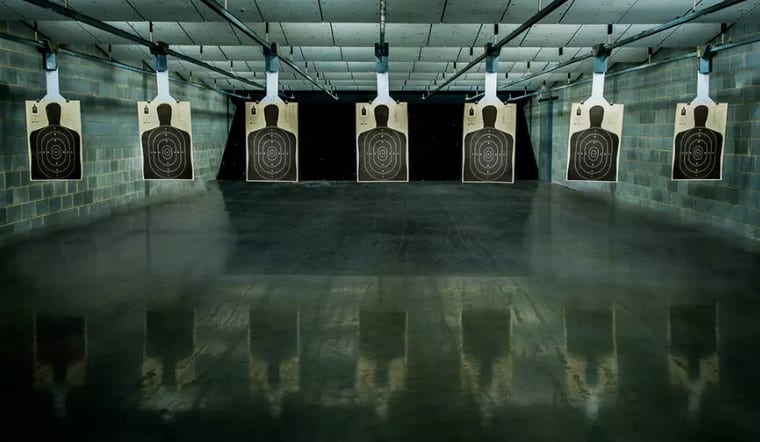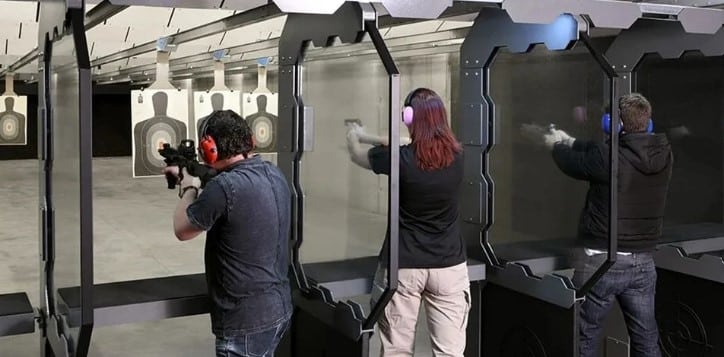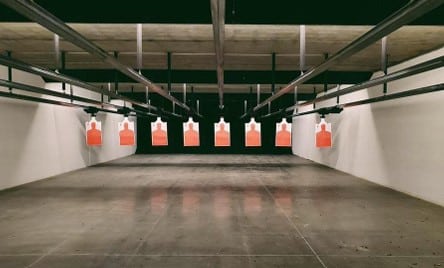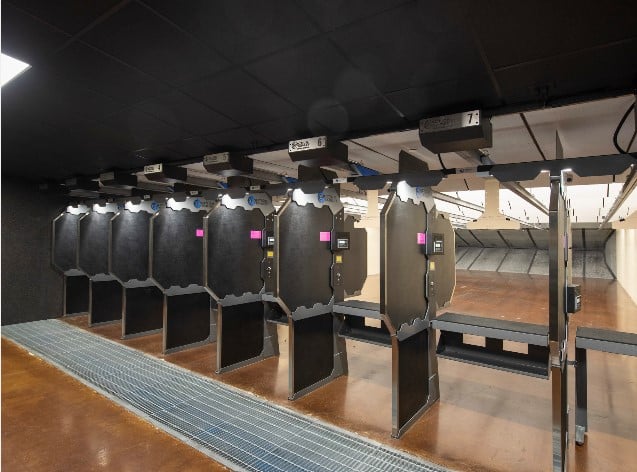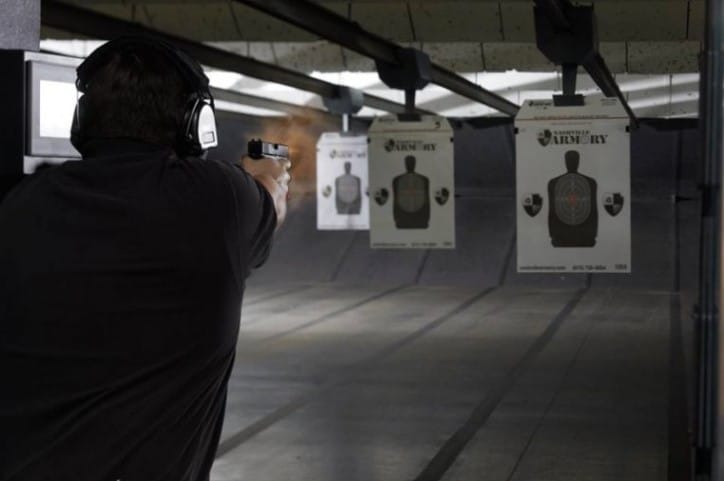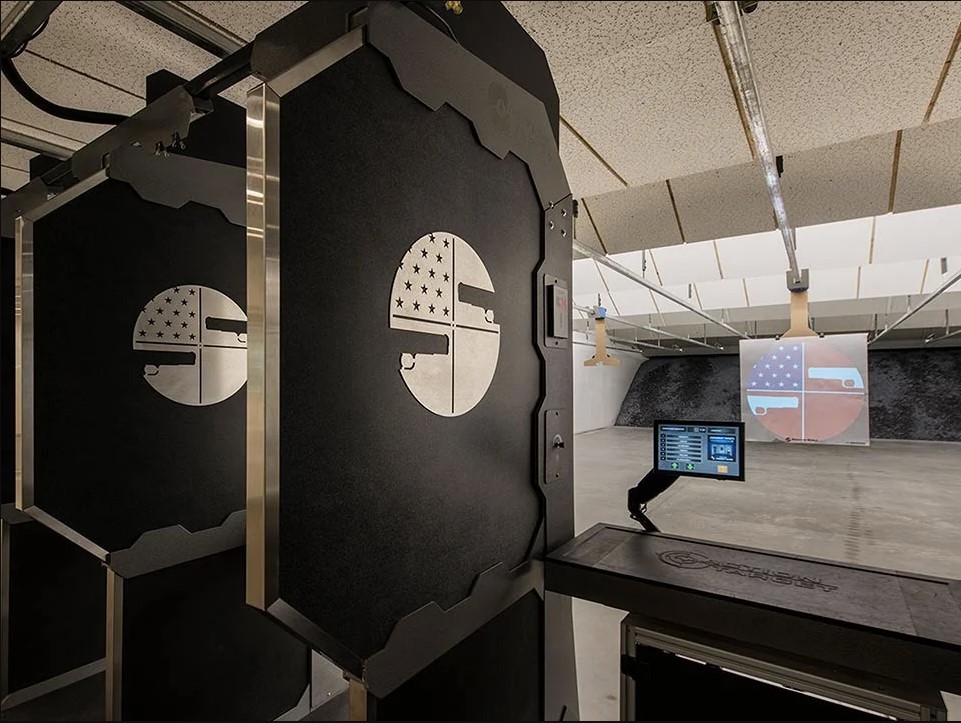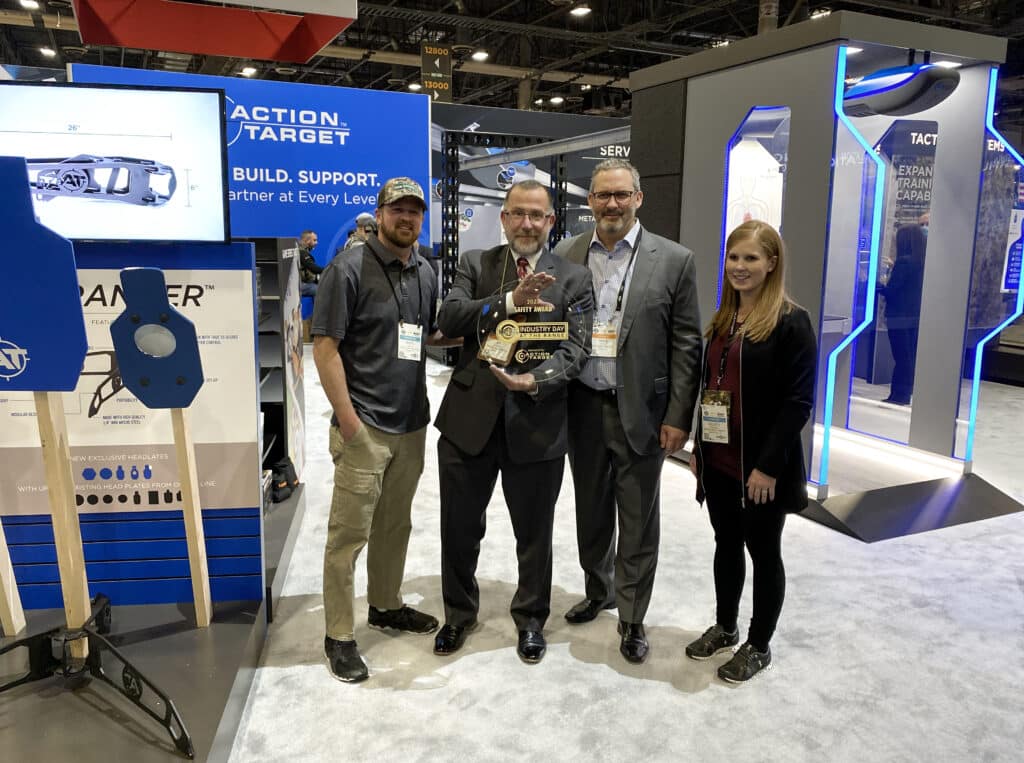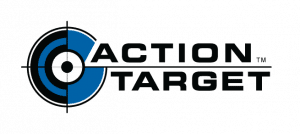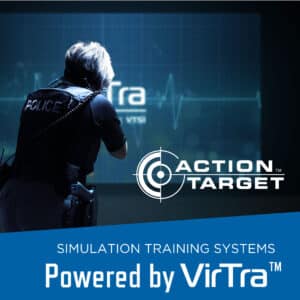You have decided to turn your passion for firearms into a business and want to build an indoor shooting range.
There are a lot of things you need to plan on, and there are probably even more questions that will arise throughout the process. One of the biggest initial questions you will want answered is: How much does it cost to build an indoor shooting range?
Generally speaking, building a private indoor shooting range will cost anywhere from $10,000 to $400K. A commercial indoor shooting range will likely cost more than $4 million. There are many additional expenses that go into an indoor shooting range.
Keep reading through the rest of the post to find out more of the specifics that will help give you a better idea of how much it costs to build an indoor shooting range. Your expenses will be much more than just the cost of the building.
How Much It Costs to Build a Commercial Indoor Shooting Range
Starting an indoor commercial shooting range isn’t an investment to be taken lightly – it’s going to cost a lot. Just how much?
Generally speaking, a commercial range will cost upwards of $3-4 million. The cost of building an indoor shooting range will vary; depending on location, building a new or modifying an existing building, materials, permitting or licensing required, and what technology you outfit your range with.
Below we’ll cover more of the specific expenses that can be anticipated when building an indoor shooting range.
Buying a Location for a Shooting Range
There is an old cliche in real estate, something about location. Whether you buy an existing building or you build a new one on an empty piece of land, the same thing will cost you significantly more in one state than it will in another.
It is easy enough to figure out the price per square foot of a property. For example, if the building is 5,000 square feet and costs $500,000, you know that you are paying $100 per square foot. This is probably an unrealistic figure, but knowing this formula will make it easier for you to understand the average commercial real estate rates in your area.
Aside from the cost of the location, you’ll need to consider if the building or property you are purchasing is zoned for a business like a shooting range. More of the specifics on zoning will be detailed later on.
Buying a Building for an Indoor Shooting Range: New or Existing?
It goes without saying that the building will be one of your largest purchases for an indoor shooting range. Determining whether to build from scratch or purchase an existing building is going to be an important decision to weigh.
In many cases, it might be more affordable to purchase an existing building for an indoor shooting range. However, if the business that previously occupied the space was not a shooting range, a significant amount of retrofitting and modifications will be required to apply the correct bulletproofing and safety features.
Whether you go with a new or existing property, you will also need to consider what your space requirements will be. We’ll take a closer look at both options below.
Using an Existing Building for a Shooting Range
If you decide to go with an existing building, there are many things to look at; by far, the most important consideration will be if the existing building you plan on purchasing can be modified and totally bulletproofed for safety.
According to guidelines on shooting range construction put forth by the US Department of Energy:
“Indoor ranges must be designed so projectiles cannot penetrate the walls, floor, or ceiling, and ricochets or back splatter cannot harm range users. Considerations should be made for cleaning of all surfaces and handling of hazardous wastes.”
There is no way around this, and it will likely be the most expensive part of utilizing an existing building. Additionally, you will need:
- Lead collection
- sound dampening
- Ventilation
Adding each of these features to your space will be a large expense as well.
Know Everything You Can About a Building’s Construction
Again, according to the Department of Energy reference above, if possible, you should try to make sure that any existing building purchased to be used as an indoor range has existing, original drawings or blueprints from the architect, engineer, or builder.
These drawings can save you a major headache when it comes to modifying the building and knowing certain traits like construction materials and load-bearing capacity.
Some Basic Requirements of Indoor Shooting Range Construction
The ceiling and the walls of your building will need to support heavy equipment like steel plates or track systems. Other criteria that need to be considered as per the above reference includes:
- General Construction Materials. It is recommended that wood and wood products as construction materials should be avoided. And any modifications that you may be able to make to ensure the building is safe will not be cost-effective.
- Exterior Walls. It is suggested that buildings with walls made of masonry or concrete are optimal. Walls should be at least six inches thick.
- Interior Walls. Walls need to be evaluated not only to prevent bullet penetration but to see if they can withstand the heavy load of the necessary range equipment. They also need to be able to contain excessive noise.
- Floors. Floors need to be evaluated to determine their capacity load.
- Ceilings. Ceilings should be at least 8-feet high and enclosed.
This is just an overview of what you need to consider. There are very detailed guidelines that need to be followed when preparing an existing space for an indoor range. Research all federal, state, and local requirements and regulations as you start shopping for a location for your shooting range.
Constructing a New Building for a Shooting Range
Constructing a new building will likely cost more, and it will require all the same specifications as were listed above for existing buildings, with a couple of important advantages:
- Fully customizable space. You are working with a clean slate and getting to build your shooting range exactly as you like.
- Ease of determining budget. The cost of building supplies varies much less than the price of real estate. As long as you already have a place to build, construction costs should be somewhat comparable from state to state.
- Experienced professionals available. If you are looking for a company or contractor to build a large building for your range, there is no shortage of talent.
You may be surprised to learn that there are many online companies that have great reputations and experience constructing buildings specifically for indoor shooting ranges.
One of these companies is Range Development Services, based in Charlotte, North Carolina. They can help provide a full scope of services and will help you develop your range from the ground up if you want. Their website features some of their past work, and the ranges they have helped design are top of the industry.
Concrete or Steel Construction for Indoor Shooting Ranges
As noted in the Department of Energy Guide, concrete is the ideal construction material for an indoor gun range. Precast concrete is pre-molded into panels and then assembled into whatever building is being constructed. This process of precasting makes concrete buildings significantly cheaper.
Precast concrete averages $275-$400 a cubic yard. A company that specializes in all kinds of precast buildings is Easi-Set Buildings. They build many different types of precast concrete buildings and have great reviews online.
Many ranges will also opt for steel buildings. Steel may be a good option if shipping costs are a concern for prefabricated concrete.
MBMI is an experienced company, in their own words, “formed by a group of top steel building professionals who focus on delivering the best products and services possible.” They fabricate high-quality steel building kits and understand many of the aspects that go into building an indoor shooting range. If you have a good idea of your specifications, they can provide you with a quote.
How Much Space Will an Indoor Shooting Range Require?
As for how much space you will need, there are even more questions to ask in order to determine the size of your range.
Space needs of an indoor shooting range depend on the number of shooters to be accommodated, how many lanes to build, whether retail space is wanted and what type of guns will be permitted on the range.
Number of Shooters and Lanes
Know how many people you want to host on the range at once. It is recommended that each lane at an indoor shooting range is approximately 5 ft wide in order to provide a safe distance between shooters.
For instance, if you want to be able to accommodate ten shooters at a time, that is going to add up to a minimum of 50 ft of width you’ll need for the range.
Retain Space
Most shooting ranges make a large portion of their income through the sale or rental of firearms and sale of ammunition. This space will be for displaying products or inventory, and it will require a space that is completely segregated from the rest of the range. This will also include customer service counters and offices.
For this, you’ll probably want at least 1,500 square feet. Every square foot of space will cost you more for your build.
Gun Types Permitted on the Range
If you plan on allowing your patrons to fire rifles and longer-range weapons, then you will probably want to make your building as long as possible. Some newer ranges have even built 100-yard indoor rifle ranges. If you only plan on allowing pistols, then you won’t need as much length.
These questions all need to be answered in order to determine what size of building or property you will need to purchase.
What Zoning Code Is Required for Indoor Shooting Ranges?
Before you commit to a property for your shooting range, zoning should be the first item to look at on your list. Zoning is a local law that applies to properties and their uses.
Oftentimes, in zoning ordinances, there is no specification about gun ranges being an allowable use for a property. This is something that needs to be confirmed depending on the location of the intended shooting range.
It is important to get zoning clarified and make sure you can be given a guarantee that your property will be allowed to operate as a shooting range. If a property is not zoned for a shooting range, it doesn’t mean it is impossible. There are ways to work around local zoning ordinances or get them amended. But again, it is important to know what the laws are regarding this before you commit to a property.
Does a Shooting Range Require a Federal Firearms License?
Anyone who operates a range will tell you that paperwork, licensing, and regulations are key in running a safe and legal business. What about a Federal Firearms Licenses (FFL)?
A shooting range is not required to hold an FFL just to operate as a range but, ranges that rent firearms or sell ammunition or firearms need to hold a Type 1 Federal Firearms License. A Type 1 federal firearms license will cost $200 for the first three years and $90 every year following.
You can apply for a federal firearms license through atf.gov. There is an application fee, and the process will include a review, background check, interview, and a final review. This whole process generally takes about two months.
What Kind of Permit Is Needed to Open an Indoor Gun Range?
To find out exactly what your requirements will be when it comes to various permits and licensing, you should contact your local government. Starting with your local city or county and state. This will likely involve more annual fees depending on where you live and should be accounted for.
After talking to these local governments, it isn’t a bad idea to call the United States Bureau of Alcohol, Tobacco, and Firearms as well. The ATF has many resources online and can probably answer any questions you may have about licensing on a federal level.
What Insurance Does an Indoor Gun Range Need?
Like any business that allows the public into its space, your indoor gun range is going to need insurance. And, since firearms bring with them an inherent liability risk, an indoor range needs some special coverage.
Gun range insurance coverage protects any or all of the following:
- Commercial general liability
- Workers’ compensation claims
- Weather-related disasters
On average, insurance estimates for a smaller range or gun club will likely cost between $87-$129 a month for insurance, according to General Liability Insurance.
This is likely to increase depending on the size of your range, the amount of coverage, and any other bells-and-whistles you add to your policy, such as cybersecurity coverage or communicable disease liability coverage.
If you are serious about building this shooting range, then it should be no surprise to you that you are going to need some serious insurance. Experienced shooters are usually well educated about the inherent risk involved with guns, but even with proper training, there is always at least a minimal level of danger involved with firearms and the general public.
How to Make an Indoor Shooting Range Safe
This subject has been saved for last because there is the most information to cover. There will also be a large number of links for products and services.
There are many companies in the United States that specialize in outfitting indoor shooting ranges for maximum safety, and they are very passionate about what they do. Some of these businesses can even help you figure out most of the other logistics and planning details required to open a shooting range.
Range Systems and Products
As there is a lot of equipment and products involved here, this is going to be a significant expense on top of buying your property or constructing your building. Most of these necessary products are at least some degree of bullet-resistant, and as such, they will be made from expensive materials.
There are companies that are leading this industry and are able to answer most, if not all, questions you may have and provide any product you will need to maximize safety for your indoor range. But no company does it better than Action Target.
Action Target, out of Provo, Utah, provides any of the range safety outfitting you’ll need as well as cleaning, testing, and monitoring services any range will need throughout its lifetime. They supply these products and services for commercial, military, law enforcement, and private shooting ranges. They have an extensive list of past clients, foreign and domestic.
Safety Products and Services an Indoor Shooting Range Needs
As for all the products the above companies provide, there are a wide variety of styles and construction materials. You’ll have to shop around and find what works for your business’s budget and needs.
The products listed below are necessary for safe operations:
- Ceiling Guards or Ceiling Baffles
These products will surely add up to large expenses for your range, but they are all important. Continuing on, we’ll cover what these items are and what their purpose is at an indoor shooting range.
Are Ceiling Guards or Baffles Needed for an Indoor Range?
Baffles are hung from overhead and are meant to keep your ceiling, lighting fixtures, target carrying systems, HVAC ducts, and plumbing or fire suppression lines from being shot while also preventing bullets shot at the ceiling from going outside.
When installed properly, ceiling baffles will not leave any exposed spots in your ceiling, saving you enormous costs compared to the other option of capping your whole roof with concrete. The materials they are made from, and their installation methods vary a little from company to company, but they do the same job.
Action Target ceiling baffles are constructed with a combination of wood, steel, and acoustic tile to help reduce sound. We have two types of baffles rated for different classes of firearms, depending on what is allowed at your range.
Does an Indoor Shooting Range Need Lane Dividers/Shooting Stalls?
Stalls are important to keep your patrons separated by a barrier as they are shooting downrange. They can also prevent injuries from accidental discharges while patrons are on the firing line.
Although the concept is the same for any of these products, they all differ slightly when it comes to bells and whistles or materials they are made out of. Some are made transparent, while others offer more privacy
For example, Action Target’s American Series Stall is a high-quality version of this shooting stall. It provides 6-foot-wide walls to maximize privacy, and the walls have an acoustic design that helps dampen sound from shots of adjacent shooters, as well as minimize muzzle blasts, or the shockwaves, from guns being fired. It can also be customized with overhead lights, a nice feature that many dimly lit indoor ranges could use.
What Is a Bullet Trap and Why Is It Needed?
A bullet trap at the end of your range is not merely a bulletproof wall.
The goal of the bullet trap is in the name; it is meant to trap or catch bullets at the end of their trajectory, where they would otherwise hit a wall. The bullet trap also aids in:
- Noise control
- Patron safety
Bullet trapping systems like Action Target’s Total Containment Trap are made out of modular parts, making them easy and more affordable to replace as they wear down. Not only does our system safely decelerate all rounds fired into them, but it also catches bullets and collects them in buckets, making the whole process of Lead Collection easier and safer.
Why Is Lead Collection at an Indoor Shooting Range Required?
An indoor shooting range is going to produce a lot of lead. And range owners need to take care of that, of course.
Collecting lead, either through systems or services, will keep hazardous airborne lead particles to a minimum, preventing contamination and preventing your employees and patrons from getting sick.
If you have a built-in lead collection, as is included with bullet traps like the ones linked above, this necessary task of disposing of hazardous material like lead can be much easier. In addition to systems that collect lead, Action Target that can provide:
- Monitoring for lead migration.
- Train your employees for the safe handling of lead.
- Test your employee’s blood levels for lead.
- Can help you develop your business’s practices for cleaning, decontamination, and disposal of lead.
Lead collection and disposal are very important for safety, but you can also recycle your collected lead for money as a nice perk.
Why Is Ventilation Required at an Indoor Shooting Range?
Again, ranges are going to produce a lot of lead. Into the bullet trap, but also into the air.
Ventilation systems can:
- Help keep lead particles out of the air.
- Provide clean air for patrons and employees.
- Help your range meet levels of compliance that are required by the standards of inspection agencies like OSHA and the EPA.
Depending on your climate, you will also need heating, air conditioning, or both, in addition to air filtration. Action Target is able to provide these systems as well as the maintenance they need.
In terms of cost, expect to pay anywhere between $25,000 to $35,000 or more per lane for a proper ventilation system.
Why Is Sound Dampening at an Indoor Range Important?
Minimizing harmful noise is a feature you will have to implement in order to meet OSHA, as well as other government agencies, standards for noise control and hearing protection.
Soundproofing companies will have a variety of acoustic materials to reduce sound, such as:
- Sound-absorbing blankets
- Acoustic foam panels
- Mass-loaded vinyl barriers
- Polyester panels
An experienced and reputable soundproofing company should also guarantee that their work will meet OSHA and other government agencies’ standards.
What Are Target Systems and Why Do You Need Them?
Target systems allow shooters to place targets down range and position them at various distances without themselves walking down range, either safely holding all other shooters up or not safely creating a dangerous situation for themselves and others.
Without a target system, patrons checking their targets will be a huge hindrance to everyone, if not impossible. With a target system, a shooter can safely evaluate their target after every round fired if they wanted to.
Action Target has multiple target retrieval systems available, and their upgradable options include many modern technologies like wireless operation, network connectivity for diagnostics, as well as cameras that can allow the shooter to check their shots on target at further distances.
Indoor Shooting Ranges Are Expensive to Build for a Reason
After you have acquired your commercial or private property, there are still many more costs that go into building and maintaining an indoor shooting range. Keeping patrons and employees safe will require a large sum of money, but that is not a cost that should be in question if you want to get into this business.
Due to the nature of firearms, you are going to need a lot of rugged materials and equipment that can stand up to gunfire, and these durable qualities are not inexpensive. In the long run, these expenses will keep all of your patrons and employees safe and allow your business to thrive.
Contact Action Target
With over 30 years of experience, Action Target can help you build the perfect range for your unique needs. Whether you’re building a commercial range that caters to casual or tactical training or a law enforcement range to better prepare your officers, our experts can help with the challenges of building a range. Talk to one of our representatives in your neck of the woods here.
Sources
https://www.clarksvillehomesales.us/indoor-shooting-range/
https://www.energy.gov/sites/prod/files/2013/05/f1/Range_Design_Criteria.pdf
https://mbmisteelbuildings.com/blog/guide-to-building-a-shooting-range/
https://rocketffl.com/ffl-cost/
https://www.rangedevelopmentservices.com/
https://www.actiontarget.com/build-range/#stalls
